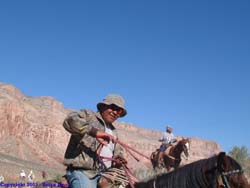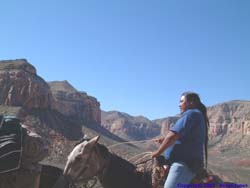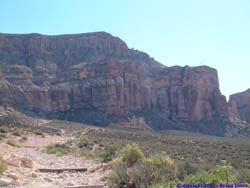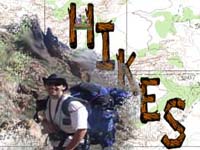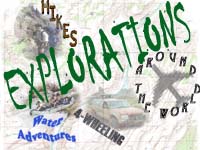Havasupai Backpacking Trip 2003: Day 3
Added 25 January 2004
Day 1 | Day 2 | Day 3
For information on Havasupai, go HERE
I wanted to get everyone moving early Monday morning because I feared that the hike back up to the trucks was going to be a slow one. The plan was to be on the trail by about 6:15-6:30, but we didn't start hiking out until closer to 7 o'clock. We dropped three packs off for the mule to take up, then continued on.
It was a very peaceful morning, and I ended up at the back of the pack, partially because I wanted to make sure everyone was doing ok and partially because I was inspired early on in the hike to write a poem about the journey. 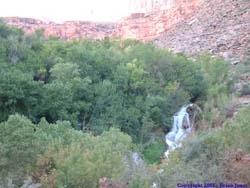
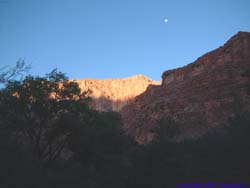 The sight of Navajo Falls and the moon set over the canyon wall as the sun was rising got me inspired. I always stayed within a fairly close distance to those in my group, but generally stayed out of conversation range so I could concentrate on the poem. Even being within earshot of their conversations pulled me out of my thoughts too much to write. So I basically hiked by myself most of the way out while I picked at the poem. I still hadn't finished it by the time the hike was done, but it was at least largely complete.
The sight of Navajo Falls and the moon set over the canyon wall as the sun was rising got me inspired. I always stayed within a fairly close distance to those in my group, but generally stayed out of conversation range so I could concentrate on the poem. Even being within earshot of their conversations pulled me out of my thoughts too much to write. So I basically hiked by myself most of the way out while I picked at the poem. I still hadn't finished it by the time the hike was done, but it was at least largely complete.
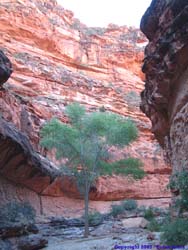
I loved hiking through Supai Village in the early morning light. 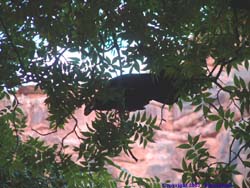 It was full of great sights, sounds and smells. The poem I wrote as I walked incorporated these experiences, including the ravens eating nuts from the trees in the village. The hike out was fairly uneventful, with the obvious exception of the wonderful beauty of the place.
It was full of great sights, sounds and smells. The poem I wrote as I walked incorporated these experiences, including the ravens eating nuts from the trees in the village. The hike out was fairly uneventful, with the obvious exception of the wonderful beauty of the place.
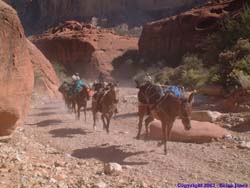
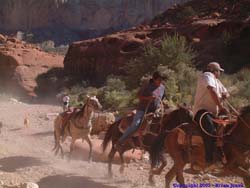 During the hike, I became fascinated by getting pictures of the Supai tribesmen herding the mule trains up and down to the village. It wasn't easy getting pictures, because they really keep their trains moving! They stop for no one. One even talked to me, but never let up from his gallop. Needless to say, it was a brief conversation.
During the hike, I became fascinated by getting pictures of the Supai tribesmen herding the mule trains up and down to the village. It wasn't easy getting pictures, because they really keep their trains moving! They stop for no one. One even talked to me, but never let up from his gallop. Needless to say, it was a brief conversation.
The last part of the hike is the toughest, when you have to climb back up the switchbacks, though it still isn't extremely difficult. As we climbed, we saw the helicopter come and go a couple of times. In the picture (below far right), you can just make out the speck of the helicopter landing on Hualapai Hilltop, the plateau at the middle right of the picture.
On the way back to Hualapai Hilltop, we stopped much less frequently than the way down, and we made much better time than I imagined in my wildest dreams. We spent more than seven hours hiking in to Havasu Falls, but hiked out in about 5 hours. I was shocked and amazed. We were at the top by around noon, and were soon driving back home. Some of us had somewhat of a scare when we got to the top though. Shannon and Janet had taken off ahead of the group, and when we all got to the top, those two were nowhere to be found. I couldn't imagine possibly getting lost on that trail, but they didn't exactly prove their trail navigating prowess on our previous backpacking trip, so I thought it might be possible. Fortunately, before we headed back down the trail to try to find them, we spotted them on a cliff overlooking the trial.
On the way back home we stopped for a late lunch or early dinner at Stromboli's in Flagstaff. It was a nice treat before hitting the road once more for that final push towards home. We were back home by mid- to late evening, thus ending our grand expedition.
I will end now with the poem I wrote while hiking out of the canyon.
October 2003
Reflections of the Havasu
Sun wax.
Moon wane.
Before the town a brown-eyed girl
with a morning disposition
rides by with a close-lipped smile.
Nut takes a journey
down canyon in Raven's craw
to start a new life, or keep one.
In the village stillness
even the rez dogs are as tranquil
as the rough hewn cliffs above.
Burning trash further on
provides a missing sense of time
as Raven's friends hang to catch
Nut's family and spirit them away
Up the trail in the world not village
walls still tower and aspire to sky
in cross-cut textures and stony clouds,
folds, faults and water chutes.
Up canyon, further, further,
there is no route but wash,
where water under gravel makes distinct footfalls
in the ripe mud red morning air
of sun first finding sandstone.
Echoes of travel and voices soon fade away
as the intimate canyon is flooded by the wash bed
revealing a broader world of greater depth
and a more revealing history.
A mule train streams by, animals streaming
under jostling loads of gear and mail,
as a prickly pear in an alcove is pondered.
The Supai man riding herd
asks the puzzling question,
"Why are you focused on that cactus?"
He should know. He . . . should know.
He daily travels the path but knows not the way.
Even here It fades.
What he has lost is made more clear
on the steep climb out, stopping,
watching over friends, community,
as Sun completes the morning
with shortening shadows and changing hues.
Many miles in the making,
suddenly it is clear that
Light comes not from above;
the sun or automotive civilization.
The shadow of the man standing here falls up,
lifted from the depths where the water
flows blue-green through earthen realms.
It comes from the reflections of the Havasu.
Day 1 | Day 2 | Day 3

 The sight of Navajo Falls and the moon set over the canyon wall as the sun was rising got me inspired. I always stayed within a fairly close distance to those in my group, but generally stayed out of conversation range so I could concentrate on the poem. Even being within earshot of their conversations pulled me out of my thoughts too much to write. So I basically hiked by myself most of the way out while I picked at the poem. I still hadn't finished it by the time the hike was done, but it was at least largely complete.
The sight of Navajo Falls and the moon set over the canyon wall as the sun was rising got me inspired. I always stayed within a fairly close distance to those in my group, but generally stayed out of conversation range so I could concentrate on the poem. Even being within earshot of their conversations pulled me out of my thoughts too much to write. So I basically hiked by myself most of the way out while I picked at the poem. I still hadn't finished it by the time the hike was done, but it was at least largely complete.
 It was full of great sights, sounds and smells. The poem I wrote as I walked incorporated these experiences, including the ravens eating nuts from the trees in the village. The hike out was fairly uneventful, with the obvious exception of the wonderful beauty of the place.
It was full of great sights, sounds and smells. The poem I wrote as I walked incorporated these experiences, including the ravens eating nuts from the trees in the village. The hike out was fairly uneventful, with the obvious exception of the wonderful beauty of the place.

 During the hike, I became fascinated by getting pictures of the Supai tribesmen herding the mule trains up and down to the village. It wasn't easy getting pictures, because they really keep their trains moving! They stop for no one. One even talked to me, but never let up from his gallop. Needless to say, it was a brief conversation.
During the hike, I became fascinated by getting pictures of the Supai tribesmen herding the mule trains up and down to the village. It wasn't easy getting pictures, because they really keep their trains moving! They stop for no one. One even talked to me, but never let up from his gallop. Needless to say, it was a brief conversation.

